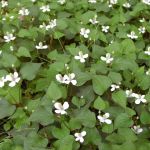| Common Name: |
Giâp cá |
| Other Names: |
Doku-dami |
| Botanical Name: |
Houttuynia cordata |
| Genus: |
Houttuynia |
| Family: |
Saururaceae |
| Native Location: |
China and Japan |
| Cultivation: |
Moist to wet, rich soil, or shallow water in sun or partial shade. |
| Propagation: |
By seed sown when ripe (species only); by division in spring; by softwood cuttings in late spring. |
| Harvest: |
Whole plants and leaves are cut in the growing season and used fresh for decoctions. |
| Height: |
15-30cm (6-12in) |
| Width: |
Indefinite. |
| Variations: |
Chameleon syn. Tricolor
Has leaves irregularly marked yellow and bright pink.
Flore Pleno syn. Plena
Has 8 or more white bracts, giving the impression of double flowers. |
| Hardiness: |
Z6-10 |
| Parts Used: |
Whole plant, leaves (yu xing cao) |
| Properties: |
A pungent, cooling herb that is aromatic and diuretic, clears fevers and toxins, and reduces swelling. |
| Medicinal Uses: |
Internally, in traditional Chinese medicine, for upper respiratory tract infections and for inflammation of the urinary tract. Externally for snakebite and skin disorders. In Vietnamese folk medicine, internally for kidney and urinary tract infections, mastitis, otitis media, hemorrhoids, and anal prolapse; externally (as crushed leaves) for urticaria, conjunctivitis, and abscesses. |
| Culinary Uses: |
Leaves are used in Vietnamese cuisine as a garnish for fish stew and boiled duck eggs; also eaten raw in parts of China. |
| Bibliography: |
Encyclopedia of Herbs by Deni Brown Copyright © 1995, 2001 Dorling Kindersley Limited. pg 237 |
